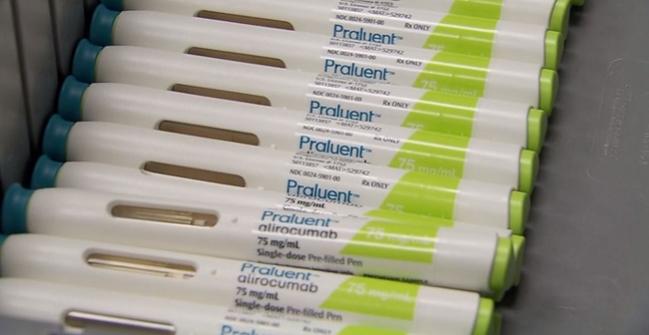Alirocumab Should Be Priced at $6,300 Annually: ODYSSEY Cost-Effectiveness Study
The barrage of economic analyses appears to have had an impact, given that the prices for PCSK9 inhibitors were lowered in 2018, says one expert.

CHICAGO, IL—If the PCSK9 inhibitor alirocumab (Praluent; Sanofi/Regeneron) is to be considered cost-effective by current willingness-to-pay standards, the drug needs to be priced at approximately $6,300 per year, according to a new economic study presented last week at the American Heart Association (AHA) 2018 Scientific Sessions.
Alirocumab would need cost even less—as little as $2,083 annually—if it is to be cost-effective when used in patients with baseline LDL cholesterol less than 100 mg/dL. In contrast, if used in patients with baseline LDL cholesterol levels of 100 mg/dL or greater, then alirocumab is cost-effective—at a willingness-to-pay threshold of $100,000 per quality-adjusted life-year gained—at $13,357 per year.
The analysis was based on the results of the ODYSSEY OUTCOMES study, a trial published just last week in the New England Journal of Medicine. Briefly, treatment with alirocumab on top of high-intensity statin therapy reduced the risk of coronary heart disease mortality, nonfatal MI, ischemic stroke, or unstable angina by a relative 15% when compared with statin therapy alone. There was a relative 15% reduction in all-cause mortality among ACS patients who received the PCSK9 inhibitor.
The absolute benefit of treatment with alirocumab was most pronounced among patients with higher baseline LDL cholesterol levels, such as those with levels greater than 100 mg/dL.
To TCTMD, lead investigator Deepak Bhatt, MD (Brigham and Women’s Hospital, Boston, MA), said the introduction of the PCSK9 inhibitors, which also include evolocumab (Repatha; Amgen), has been a major advance in cardiovascular medicine, but cost has limited their use. The prior authorization process is onerous, for one thing. Another issue is that physicians are skeptical of the drugs’ value at the initial list price, according to Bhatt.
The goal of their cost-effectiveness analysis was to use the trial data to determine the price in which the drug would have value. The researchers did not make any assumptions about the drug’s actual price—it had initially been listed at more than $14,000 annually but has since been reduced in an exclusive deal with the pharmacy benefits manager Express Scripts—given that it frequently differs from the list price due to various confidential discounts. Using diagnosis-related group costs from Medicare, each cardiovascular death, nonfatal MI, nonfatal ischemic stroke, and ischemia-driven coronary revascularization or unstable angina was pegged at $20,225, $18,862, $12,617, and $39,531, respectively.
“Using the ODYSSEY OUTCOMES trial event rates and costs, and making some assumptions about what happens on a longer-term horizon than the trial itself, we determined that a price of approximately $6,300 or below would be the price at which the drug provides value,” said Bhatt. “My hope is that in the future, this evidence-based approach is used to set the list price of drugs, as opposed to pricing a drug at whatever level a company hopes the market will allow.”
New guidelines for the management of cholesterol published this week carved out a space for PCSK9 inhibition. The drugs can be used in very-high-risk patients with atherosclerotic cardiovascular disease with LDL cholesterol levels ≥ 70 mg/dL. The guidelines recommend adding ezetimibe first to lower LDL cholesterol, but if that agent fails to lower LDL beyond the 70-mg/dL threshold, then a PCSK9 inhibitor is a reasonable option (class IIa).
Speaking during the late-breaking clinical trial session, Andrew Moran, MD (Columbia University Irving Medical Center, New York, NY), agreed that high out-of-pocket costs, among other barriers, have limited use of the PCSK9 inhibitors. Since they became commercially available in 2015, the manufacturers have come under constant fire for initially pricing the drugs so high. Numerous economic analyses published and presented to date have suggested the drugs need to cost between $4,000 and $9,000 per year to be considered cost-effective.
“Rarely has a cost-effectiveness analysis had such an impact on cardiovascular disease drug pricing as with these agents,” said Moran.
There are several strengths of the latest cost-effectiveness analysis, added Moran, noting that efficacy data, health-related quality of life, and healthcare utilization are all based on values measured directly from ODYSSEY OUTCOMES. He pointed out, however, that only acute cardiovascular costs were considered in the economic analysis. Not including all background noncardiovascular costs—the future costs of accrued medical therapies for patients kept alive by alirocumab—can attenuate the cost-effectiveness of therapy, said Moran.
Photo Credit: http://www.news.sanofi.us
Michael O’Riordan is the Managing Editor for TCTMD. He completed his undergraduate degrees at Queen’s University in Kingston, ON, and…
Read Full BioSources
Bhatt DL, Briggs A, Reed SD, et al. Cost-effectiveness of alirocumab based on evidence from a large multinational outcome trial: the ODYSSEY OUTCOMES economics study. Presented at: AHA 2018. November 10, 2018. Chicago, IL.
Bhatt reports receiving grants from Abbott, Amarin, AstraZeneca, Bristol-Myers Squibb, Eisai, Ethicon, Medtronic, Regeneron, PhaseBio, Idorsia, Synaptic, Sanofi Aventis, Roche, Pfizer, Forest Laboratories/AstraZeneca, Ischemix, Amgen, Lilly, Chiesi, Ironwood, and The Medicines Company; other from FlowCo, PLx Pharma, Takeda, Svelte, Boehringer Ingelheim, Novo Nordisk, Merck, St. Jude Medical (now Abbott), Biotronik, Cardax, Boston Scientific, Medscape Cardiology, Regado Biosciences, the Boston VA Research Institute, Clinical Cardiology, and the VA; personal fees from Boehringer Ingelheim, the Duke Clinical Research Institute, Mayo Clinic, the Population Health Research Institute, Belvoir Publications, Slack Publications, WebMD, Elsevier, Cleveland Clinic, Mount Sinai School of Medicine, the Harvard Clinical Research Institute (now Baim Institute for Clinical Research), HMP Global, TobeSoft, Bayer, and the Journal of the American College of Cardiology; personal fees and nonfinancial support from the American College of Cardiology and the Society of Cardiovascular Patient Care; and nonfinancial support from the American Heart Association.
Moran reports no conflicts of interest.


Comments